Hair therapy
Hair mesotherapy is a new generation of mesotherapy that helps stop hair loss, stimulates hair growth and strengthens hair at the same time.
Effect of the procedure
- stopping excessive hair loss
- hair growth restoration
- prevention of hair loss
- regeneration of damaged hair
- supplying nourishment to the hair roots
Therapy options
- Hair cocktails
- Plasmotherapy
- Stem cells
What is natural hair loss?
Healthy hair follicles produce hair thanks to the intense cell division of the hair bulb. Naturally, a person loses about 100 hairs per day. We lose more hair in spring and autumn than in other seasons. Hair density ranges from 180 to 330 hairs per 1cm2 and is mostly genetically determined. The growth rate of healthy hair averages 1 centimeter per month.
Excessive hair loss affects up to half the population, around 60% of men and 30% of women. If hair starts to fall out excessively, this is called effluvium and leads to thinning hair and even baldness, called alopecia. Excessive hair loss can affect the entire hair shaft or only circumscribed areas of the hair shaft - so called alopecia areata.
Hair growth phase differentiation
The length of hair growth is 3 to 7 years and is divided into 3 phases. After that, the hair is released from the hair follicle and falls out. The duration of each phase and the number of hairs is partly genetically determined.
Growth - anagen phase - the hair is connected directly to the follicle, it grows on average 1 cm per month. The growth phase lasts from 2 to 6 years. In a healthy person, about 85% of all hair is in the anagen phase.
Transitional - catagen phase - then the follicle begins to shrink and the hair detaches from the base of the hair bulb, loses its nutrient supply and stops growing. The catagen phase lasts for 2 to 3 weeks and is found in about 1% of the hair on the head.
The resting - telogen phase - the hair follicle is inactive, only regenerating, the hair does not grow. The resting phase lasts about 3 months and about 14% of the hair is in this phase. At the end of the telogen phase, the follicle enters the growth phase again and hair starts to form again. If old hair still remains on the head at this time, the new growth pushes it out and starts a new growth cycle.
Exogenous phase (hair loss, also early anagen) - after the resting phase ends, a new hair starts to grow from the hair bulb. It pushes on the previous one from below and eventually causes it to fall out. This causes the whole cycle to go back to the anagen phase and repeat.
What are the causes of hair fall
- Hormonal imbalance -decline in estrogen levels, thyroid disorders
- Androgenetic alopecia - more common in men
- Insufficient nutrition - lack of iron, zinc, starvation, excessive dieting
- Seasonal hair loss - spring and autumn effluvium
- Hair damage - UV rays, dyeing, mechanical treatment
- Stress - fevers, emotional stress, serious injuries, surgery
- Use of certain medications - hypolipemics, chemotherapy, antidepressants
How mesotherapy treats hair fall?
Hair mesotherapy works on several levels. It is a targeted, minimally invasive procedure that helps stop hair loss while stimulating hair growth and improving hair quality. The active ingredients applied with microneedles revitalize the hair bulbs, increase blood circulation, and thus improve the hair cover.
Thanks to mesotherapy:
- Hair roots get the nutrition they need
- Improves the condition of the scalp
- Hair is thicker, stronger and shinier
- The skin gets better blood circulation, which helps to nourish and oxygenate the cells
Mesotherapy is effective against hair loss of various origins, but has no effect on dead follicles and atrophied, i.e. thickened and shrunken, hair bulbs.
What do serums for hair mesotherapy contain
Regenerative medicinal solutions for hair mesotherapy usually contain unsaturated hyaluronic acid and other effective natural extracts that nourish the hair follicles. This is an active complex of minerals, biotin to stimulate cells, vitamins - biotin (vitamin H) to stimulate cells, vitamin E, trace elements - selenium zinc, iodine, sulfur-containing amino acids, fatty acids, flavonoids.
How the treatment takes place
The procedure includes a consultation with a doctor to determine the cause, assess the degree of damage and then prepare a cocktail. The anaesthetic solution is applied 20 minutes before the treatment begins and then a thin needle is used to introduce the medication into the scalp. The procedure takes 30-60 minutes, and usually 6-8 treatments are needed to achieve the final effect. Hair treatment with plasma therapy Platelet rich plasma (PRP) therapy is a relatively new method of promoting hair growth, which has begun to be used in the treatment of androgenetic alopecia. The method involves injecting the patient's own growth factor-rich plasma into the scalp. The goal of PRP therapy is to stimulate hair growth by increasing blood flow and cellular activity in the hair follicles. Plasmotherapy alone is certainly not the first choice in the treatment of alopecia.
Differences between hair loss in men and women
The cause of male pattern baldness called androgenetic alopecia is the sensitivity of hair to testosterone. If the amount of testosterone in the hair bulbs is elevated, the hair gradually begins to fall out. Hair loss is creeping, typically by the formation of so-called nooks or bald spots on the top of the head, and is genetically determined.
In women, hair loss is most often caused by hormonal changes - puberty, pregnancy or menopause. Most women experience an overall thinning of the hair rather than a visible baldness. Thinning can occur on the front, sides or top of the head. Hair may also fall out in large clumps during combing and showering.
Diffuse alopecia - the most common cause of hair loss
The predominant cause of excessive hair loss is its rapid transition to the telogen or shedding phase. There can be a number of reasons for this - stress, febrile illnesses, difficult surgeries or the use of certain medications. Hair loss usually occurs two to three months after the triggering factor. Damage to the hair bulbs is usually a one-time event and usually results in re-densification.
Changes in hair quality after fifty
Hair loss during menopause is a result of hormonal imbalance. Thanks to estrogen and progesterone, hair grows faster and stays on the head longer too. But once these hormones start to decline, hair grows slower and is thinner. The decline in these hormones also causes a relative increase in male androgens. These reduce the activity of the hair follicles, leading to hair loss and sometimes, in turn, to facial hair growth. This is why some menopausal women develop facial and chin hair.
For maximum support of hair growth, the treatment should be repeated
Since hair renewal is a long-term physiological process, it is necessary to repeat the treatment. The procedure is usually performed once a week or after 14 days, for a total of 4-12 treatments depending on the extent of the changes, the cause and the desired result. The hair bulbs thus receive regular care, which is crucial for their positive stimulation. Visible improvement of the scalp and hair is usually visible after 1-3 months.
From our blog:

Menopause and skin after 50
During the period of transition, the female body undergoes a whole series of changes....
Read more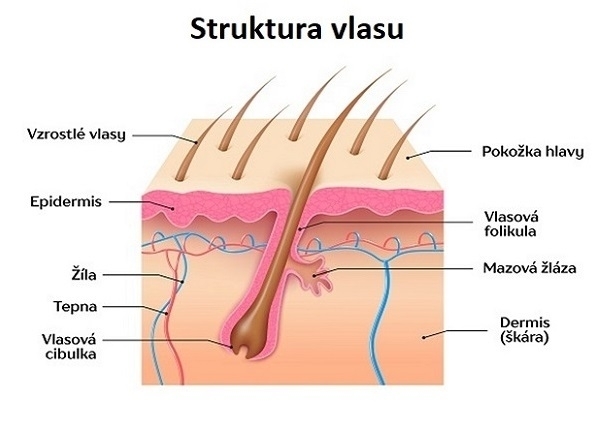
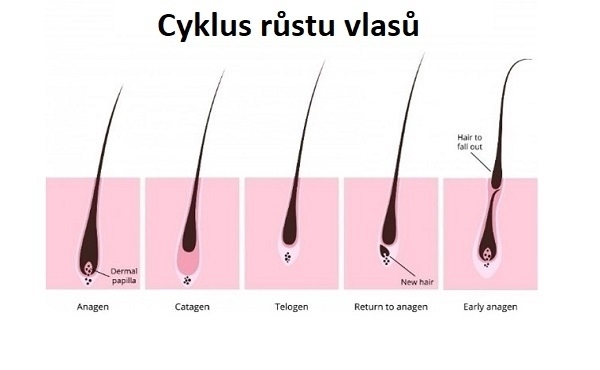
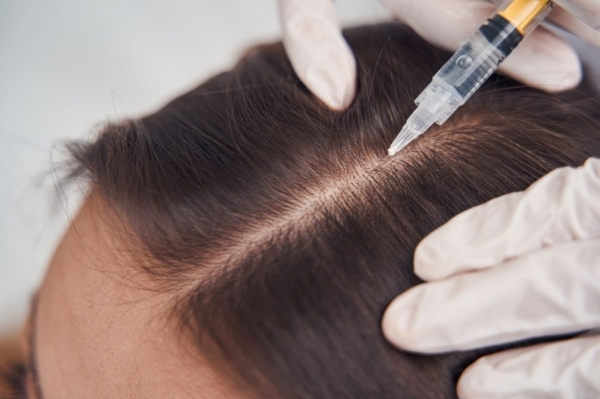
Hair mesotherapy for thinning hair follicles
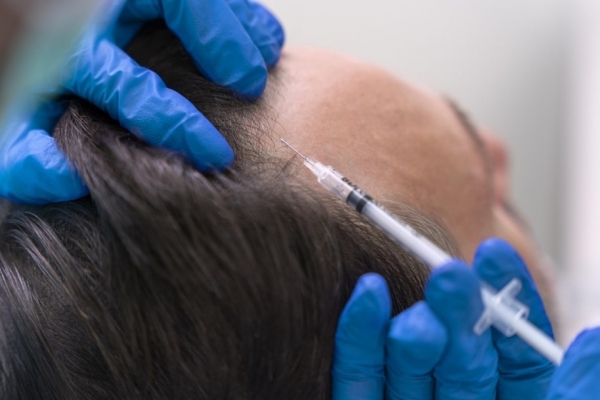
Hair mesotherapy hair loss corners, the most common type of male alopecia
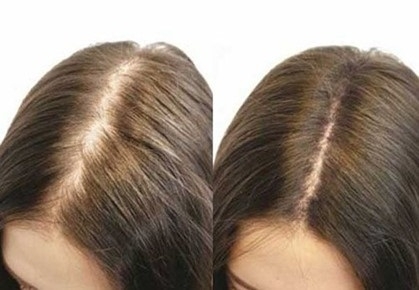
Overgrowth of the hair follicle after a series of mesotherapies
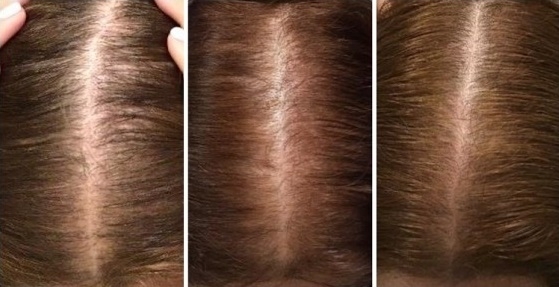
Gradual thickening of hair after treatment after half a year
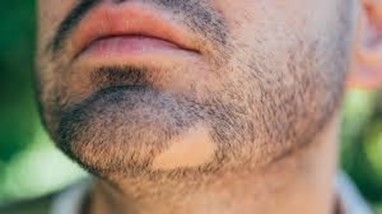
Bearing beard loss- alopecia areata

